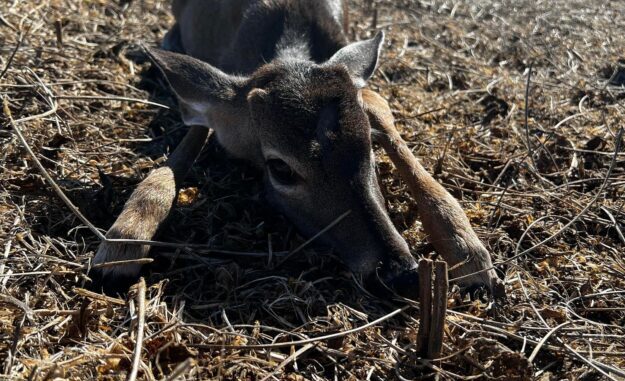
Blue tongue – properly known as epizootic hemorrhagic disease – is more widespread in whitetail deer this year, according to wildlife officials.
Scattered observations of sick and dead deer due have been reported across the foothills, Piedmont and Coastal Plain of North Carolina over the last month, officials with the N.C. Wildlife Resources Commission said. The WRC is asking that citizens report dead or obviously sick deer to their local district wildlife biologist to help monitor the impact of the disease on deer herds.
“Hemorrhagic disease is a common disease in southeastern deer populations that causes sporadic outbreaks every few years, typically resulting in dead deer found near water in late summer,” said Moriah Boggess, deer biologist for the Wildlife Commission. “The term hemorrhagic disease is collectively used for both Blue Tongue and Epizootic Hemorrhagic Disease viruses, both of which cause similar symptoms in deer.”
Hemorrhagic disease is very different from Chronic Wasting Disease (CWD), which was first detected in North Carolina this year in two deer from Yadkin County.
Blue Tongue and Epizootic Hemorrhagic Disease have both been confirmed in tissues submitted to laboratories for testing, with numerous more samples pending results. Samples for CWD testing have also been submitted to the laboratory and are pending results. It is still too early in the disease outbreak to determine whether there will be any significant population impacts; however, even following severe hemorrhagic disease outbreaks deer populations typically rebound in a few years.
“An important difference between the two diseases is that deer, especially in the South, are adapted to hemorrhagic disease because it’s been here as long as we have deer records, but CWD is a relatively new deer disease. Even in the worst hemorrhagic disease outbreaks some deer survive and pass on their immunity to offspring,” said Boggess.
“CWD on the other hand is incurable and deer that contract the disease cannot survive it. While it may seem like hemorrhagic disease kills more deer in the short term, the future implications of CWD are much grimmer, because CWD permanently affects population viability and infection rates steadily climb each year.”
Sick deer suspect of having hemorrhagic disease have been reported in 39 counties in the state, with the highest frequency of reports from the Mountains and Piedmont regions. Southeastern North Carolina usually sees more cases in late August and September, with cases tapering off in early October.
Once a hemorrhagic disease outbreak begins, it usually continues until weather conditions until the first frost of fall. Some deer that are harvested this fall may have rings in their hooves or scars in the dental palate, Boggus said. Both are signs that a deer was infected with hemorrhagic disease and recovered.
Hemorrhagic disease is not transmissible to people through the biting midge or consumption of meat.
For more information on hemorrhagic disease, visit the Wildlife Commission’s webpage on deer diseases. More information on CWD is available at ncwildlife.org/CWD.
































